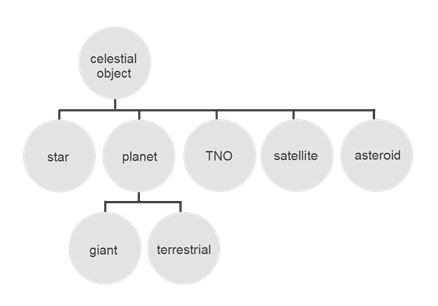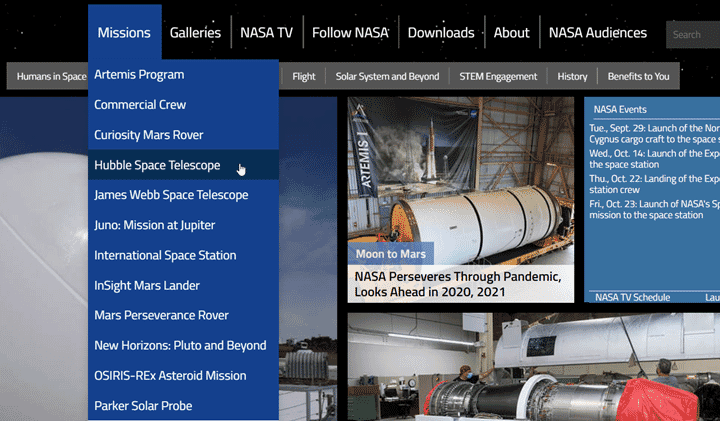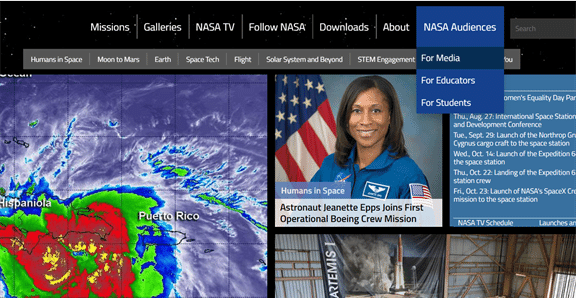Finding the right information can be a nightmare for users in our increasingly digitized world. A simple solution is taxonomy.
But what is taxonomy, and why should you use it?
In this blog, you will learn how to use taxonomy, and how it can improve user satisfaction.
What Is Taxonomy?
According to Bob Bater, the author of ‘’Practical Taxonomies,’’ a taxonomy “Formalizes the hierarchical relationships among concepts and specifies the term to be used to refer to each; it prescribes structure and terminology.’’
Think of taxonomy as a way of classifying things or concepts by hierarchy. When creating a taxonomy, it is important to define taxonomy terms to ensure an accurate classification of concepts.
Below is a simple example of a taxonomy:

“Star,” “planet,” “TNO,” “satellite,” and “asteroid,” are all types of celestial objects.
Once a classification is created, the values which are added to the classifications might evolve overtime.
For instance, in the automotive industry, new car models like SUVs have emerged over the past 50 years, and are now classified under “car models,” next to ‘mini-vans”, and “convertibles.” Other car models have been discontinued.
Therefore, taxonomies can evolve in the sense that customers’ needs also change, and organizations need to adapt classifications to reflect it so that customers are informed correctly. The overall taxonomy structure; however, remains the same.
Here is a real-life example of taxonomy on NASA’s website. It shows several facets of NASA “Missions” created by tagged content on the website.

The elements below ‘’Missions’’ are classified directly under it.
By adding taxonomy to content, the user can easily find it, which in turns allows one to leverage content with dynamic delivery while enhancing user experience.
Where to Find Taxonomy in Your Organization?
Quite often, taxonomy already exists in organizations, but people do not know where to find it. Any company that has a website within which information is classified owns one or more taxonomies. These taxonomies can be owned by different people, which makes it essential for these different teams to communicate with each other.
Here is where one can find taxonomy in an organization:
- Internal governance group
The way classification is handled depends on the organization’s size. In larger organizations, the process is more formal and involves representatives from several divisions. In small organizations, a few people are responsible for maintaining it.
Communication between stakeholders is essential in both instances to ensure that classification values are used effectively within content and for delivery.
- Index terms
Index terms are subject descriptions that the author makes available to help readers navigate the content. They can serve as a great resource to start a taxonomy or to help validate all the ways people look at content in your classification.
- Find any current keywords or tags
Keywords and tags are assigned to content.
Marketing, product owners, and website managers are generally the people who have access and ownership of taxonomy.
Dynamic Delivery: a Taxonomy Use Case
User experience is at the core of taxonomy. In dynamic delivery websites, users can easily access the content they are looking for.
DITA, a proven open-structured standard, is commonly used to build dynamic delivery websites. DITA topics are dynamically created based on the taxonomy classification system used. All the concepts under a taxonomy are grouped together, making navigation and search intuitive. This further stresses the importance of using the right terms when starting a taxonomy, and to have the right governance in place.
The richer the taxonomy— and the more specific the application to granular content units—the more sophisticated the user experience will be.
Which Taxonomy Values Should You Use?
Taxonomy values include numerous grouping options. These include the following:
- Permissions
- Audiences
- Product classifications
- Use cases or tasks
- Industry classifications
- Subject classifications
- Content types
The most crucial thing to have in mind when creating terms for a classification is consistency. Clear and consistent tagging will guarantee a uniform experience for customers.
In a word, the most robust taxonomies are designed based on how the end user is expecting to use them.

The example above uses audience taxonomy values: “For Media,” “For Educators,” and “For Students.” These are different facets of NASA Audiences that are dynamically created based on the content, and on what the taxonomies have within them.
Taxonomy in Action
Taxonomy aims to power up user experience. There are various ways to use taxonomies:
- Search engines
In addition to classic navigation through menu bars, taxonomy enhances search engines. One way of achieving this is by having keywords in a taxonomy.
Note that a keyword can exist in multiple classifications. In this case users should be able to filter search results using faceted search to refine search criteria with certain values and categories.
- Deliverable organization and presentation
Menus at the top of websites are good visualizations of the taxonomy hierarchy that we see in the taxonomy management tool.
- Content control and presentation, and platform configuration
Taxonomy can be more complex and sophisticated to create different and tailored user experiences for different user types.
Where Does Taxonomy Live?
Taxonomy can live in DITA content.
Maps and topics both have <metadata>. Within metadata are the <category> and <keyword>. Taxonomy terms live in the <category> or <keyword>.
Once taxonomy terms and governance have been selected, it is up to the tool to implement taxonomy on your dynamic delivery website.
With a CCMS like MadCap IXIA CCMS, you can tag content, and put taxonomy values into <category> or <keyword>. Once you generate output and get the HTML files, the dynamic delivery platform will read them.
Pitfalls to Avoid
- Do not just alphabetize terms
Taxonomy should be categorized by hierarchy.
- Don’t lose track
Keep it all in one place, even if it is not with your team.
- Do not start over and do not ignore other people’s work
Be sure to leverage whatever your company already has.
- Do not forget the delivery method
Taxonomy terms can be used in different places such as websites, help applications, and other outputs. Taxonomy should be built with regards to the method selected.
- Do not ignore the delivery team
Communication within teams and the overall organization is key.
- Don’t try to do it on your own
You’ll need all the help you can get.
- Don’t give up!
It’s all worth it.
Building taxonomy is a journey: it takes time, and requires people to support you along the way. The return on investment, however, makes it a worthy cause. Not only will your organization have a consistent way of structuring content, but users will also benefit from a significantly improved experience.
—
This blog was originally presented as a IXIAtalks webinar by Boris Roberto Aguilar from IXIASOFT and Amber Swope from DITA Strategies Inc. You can find the webinar here.
Learn more about our IXIAtalks webinar series.






